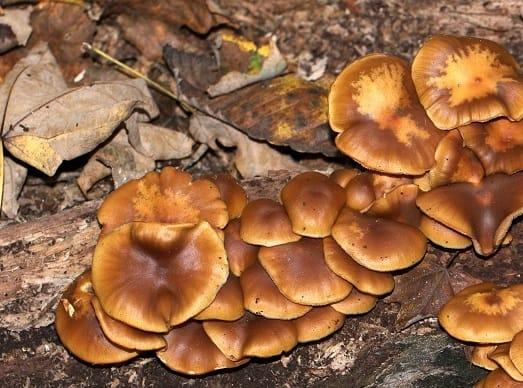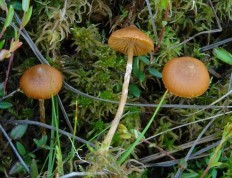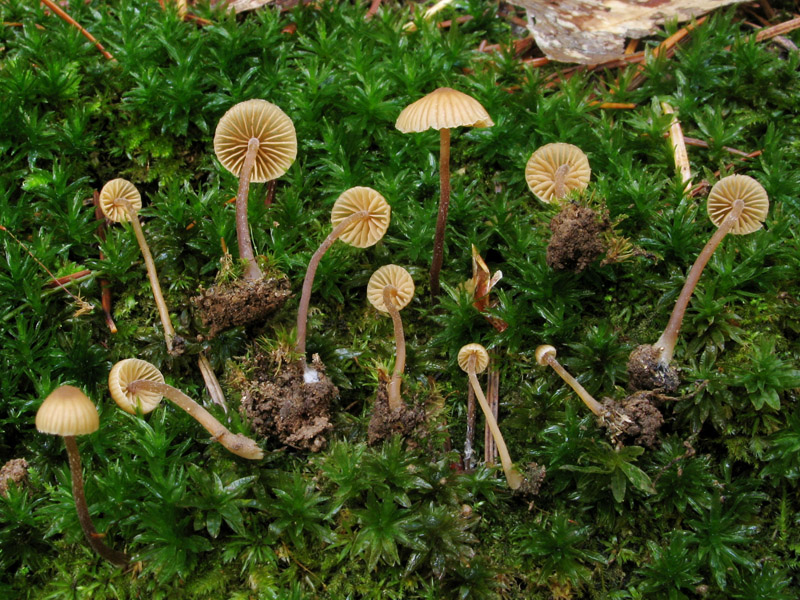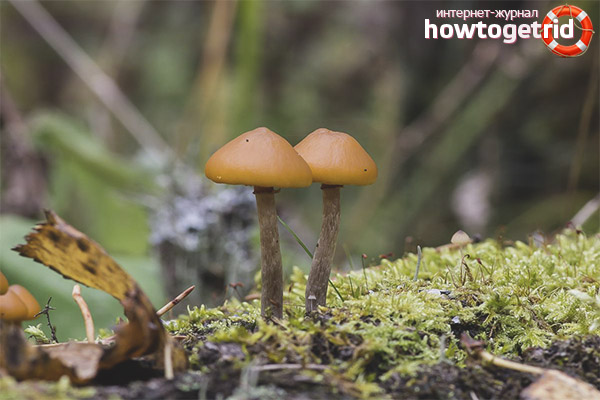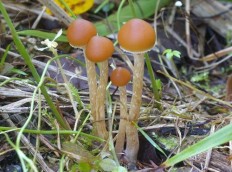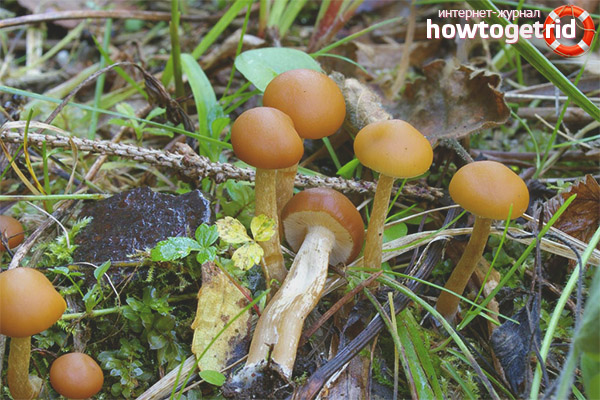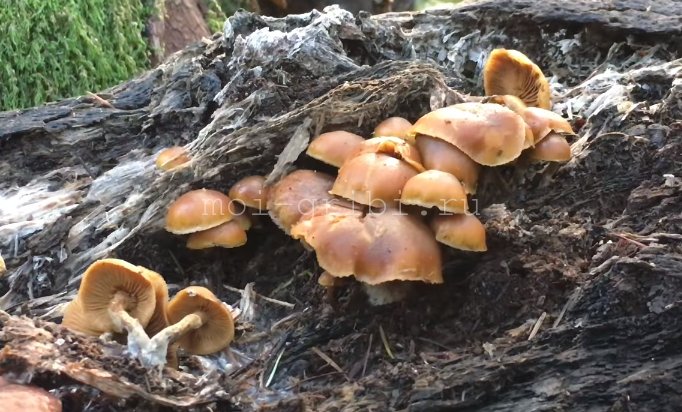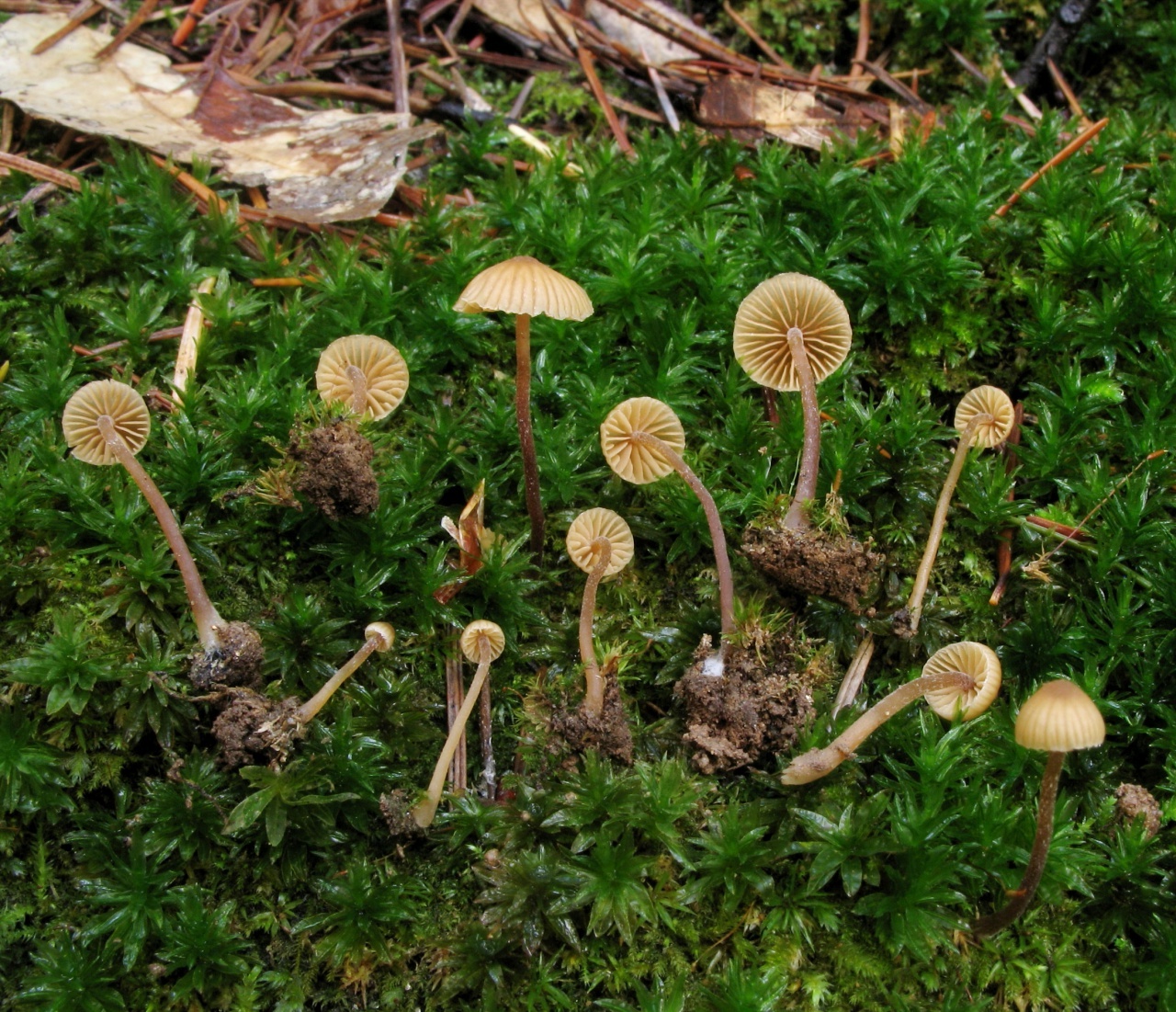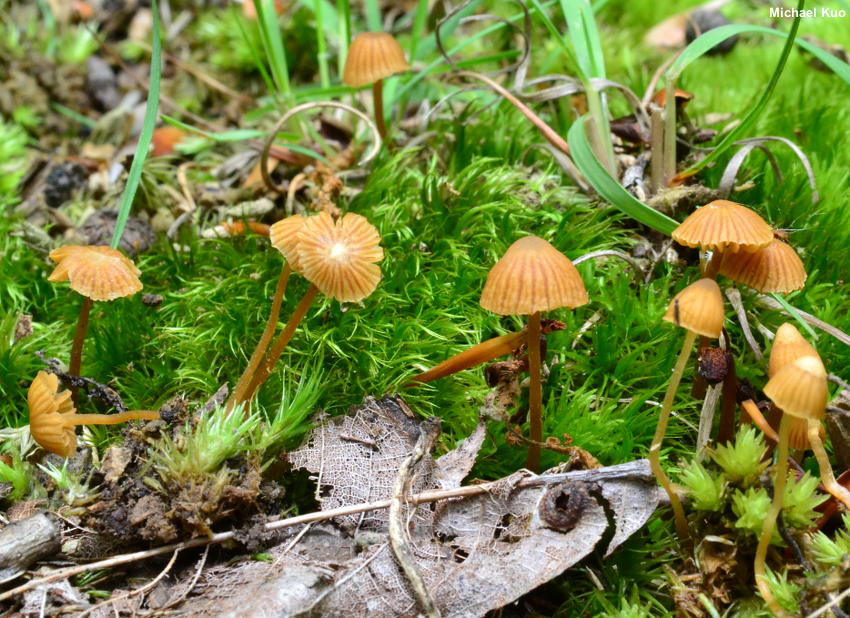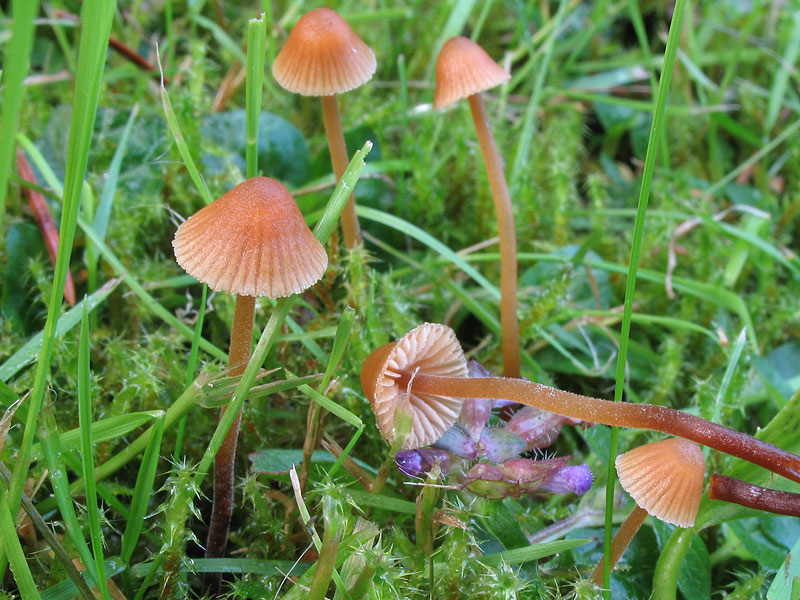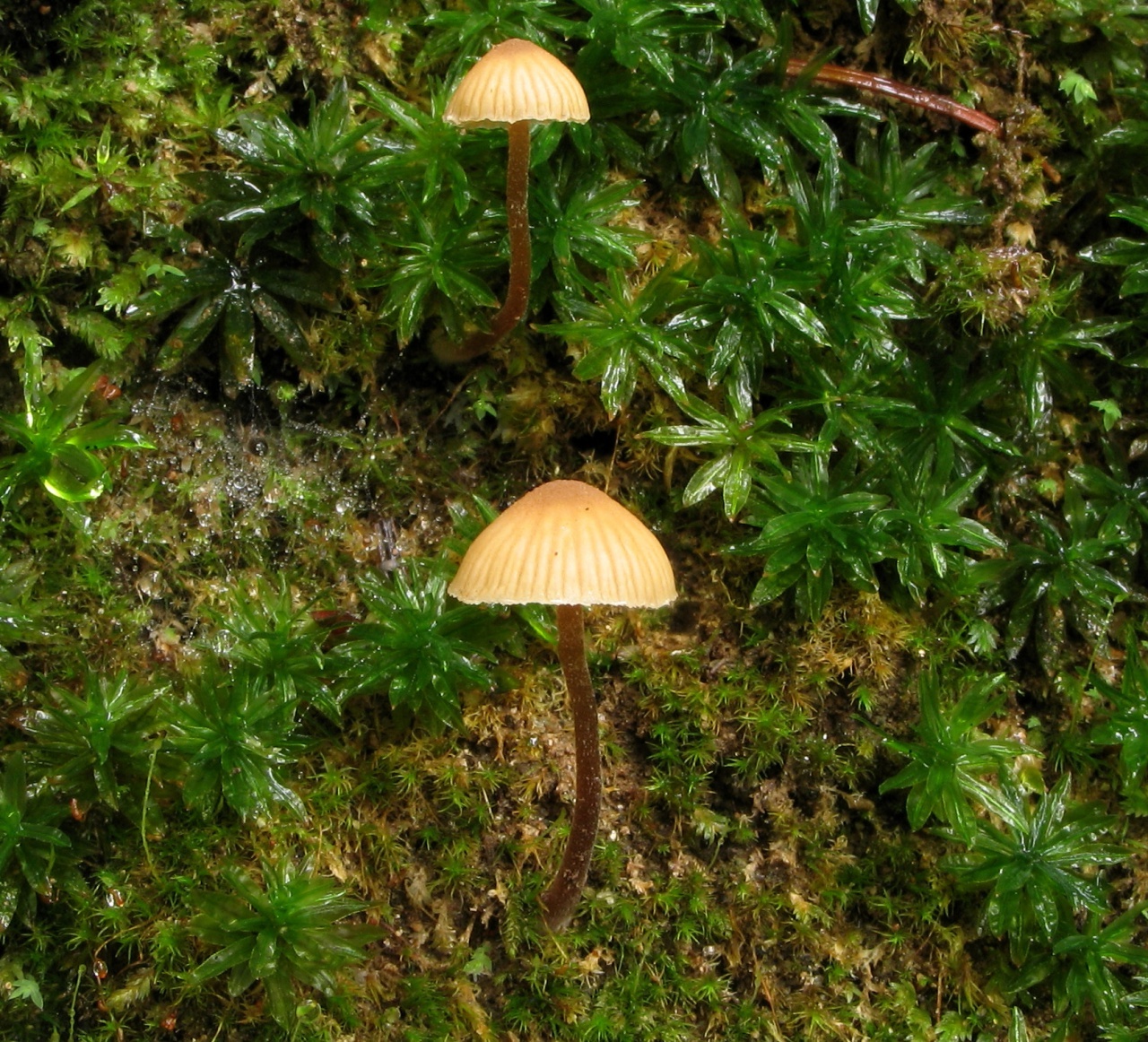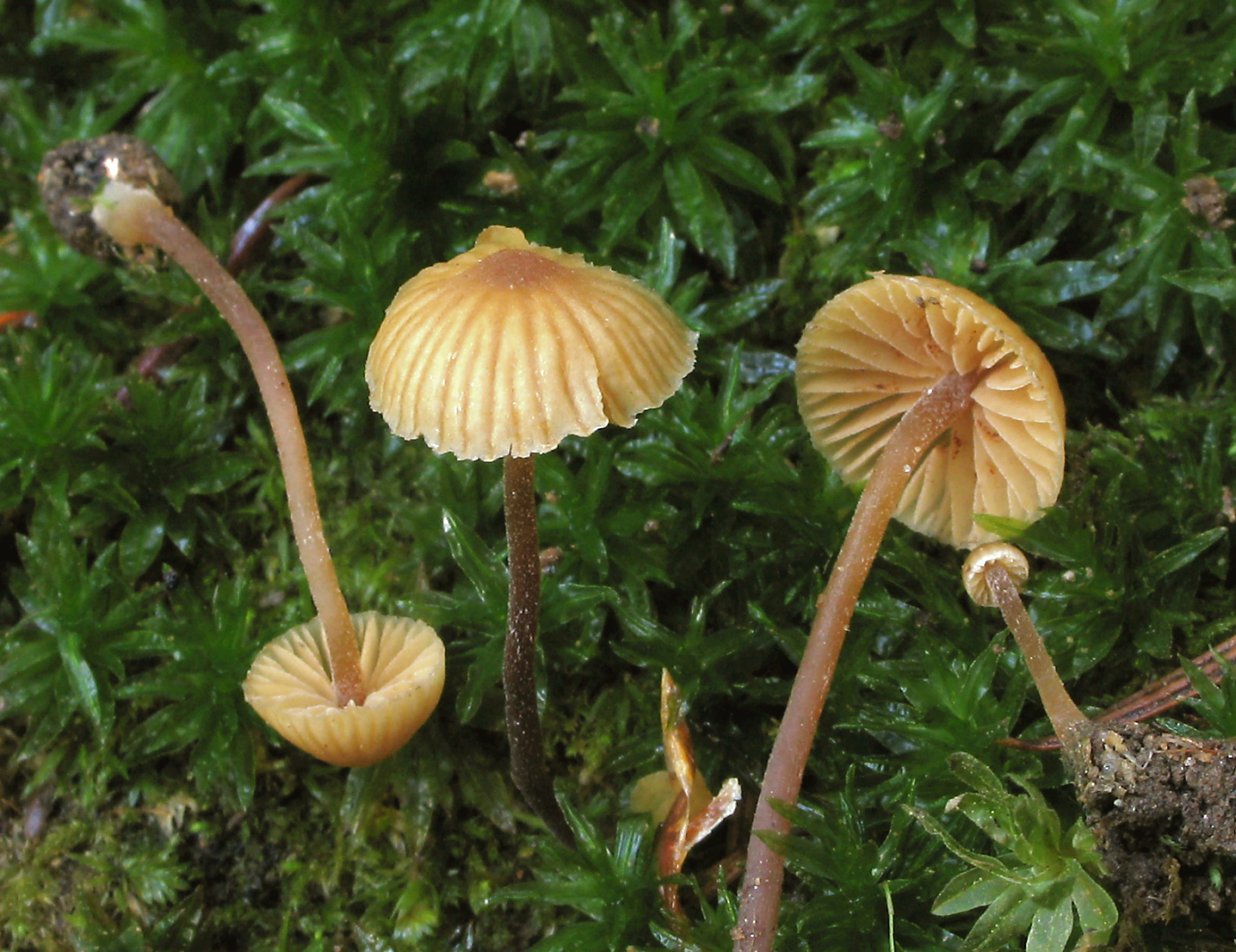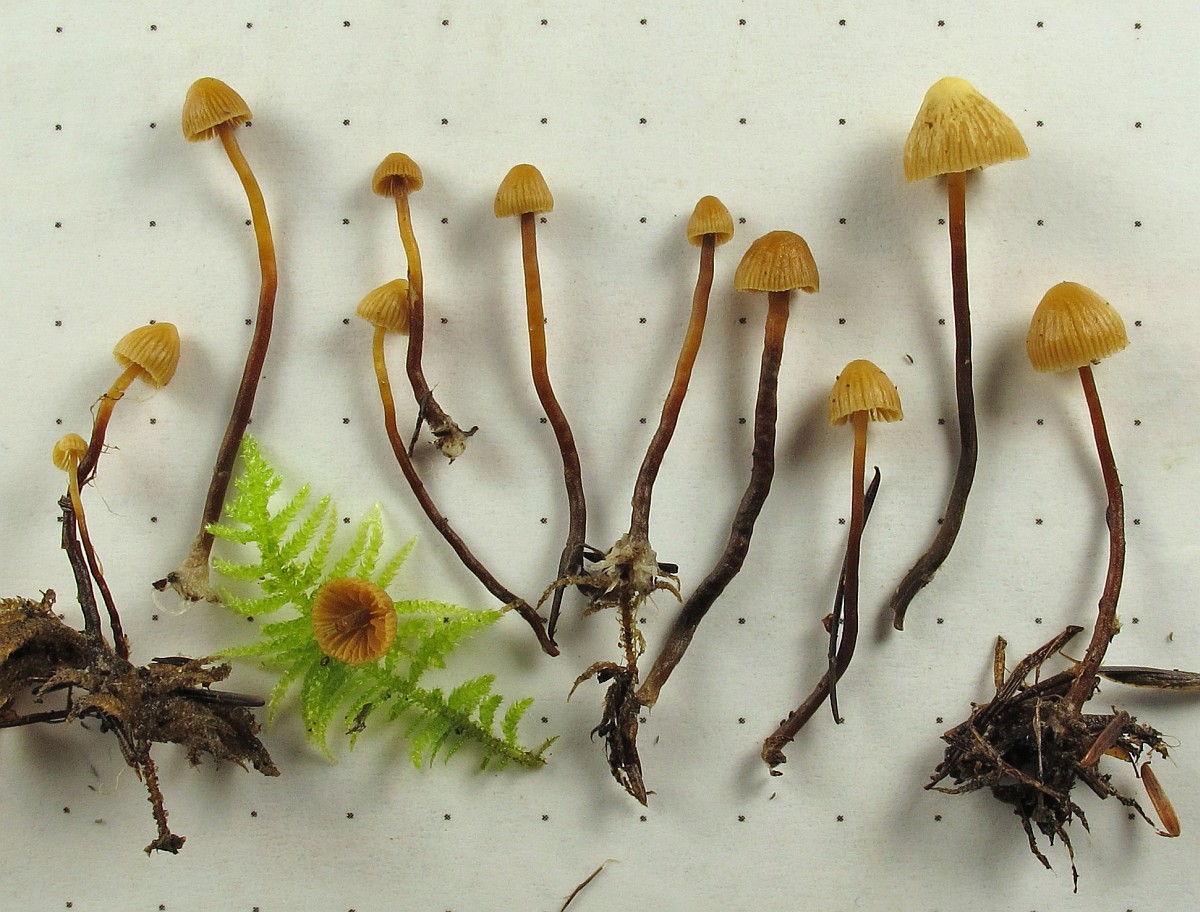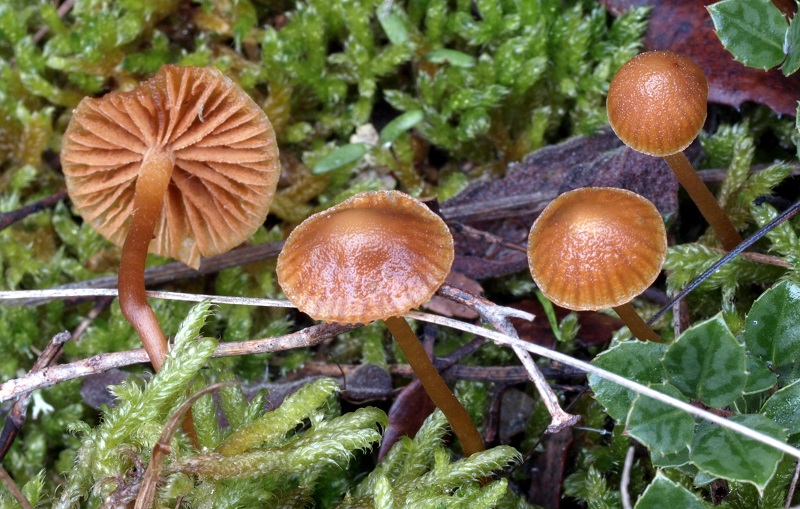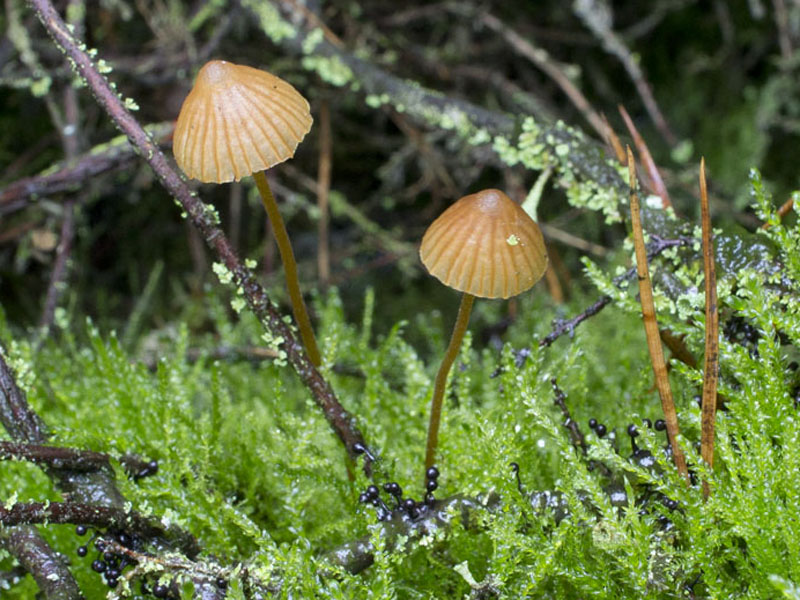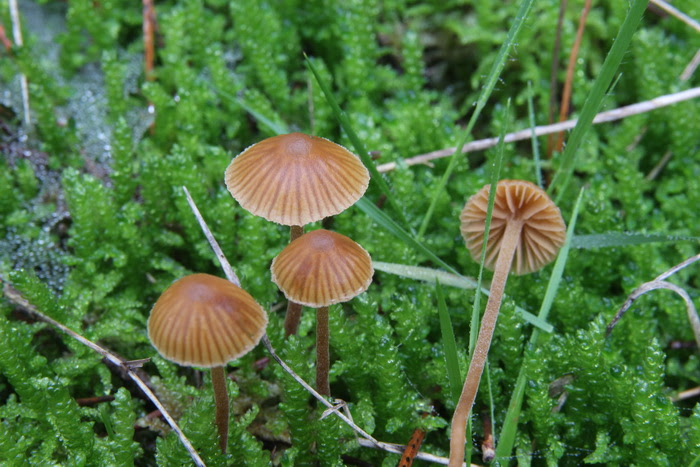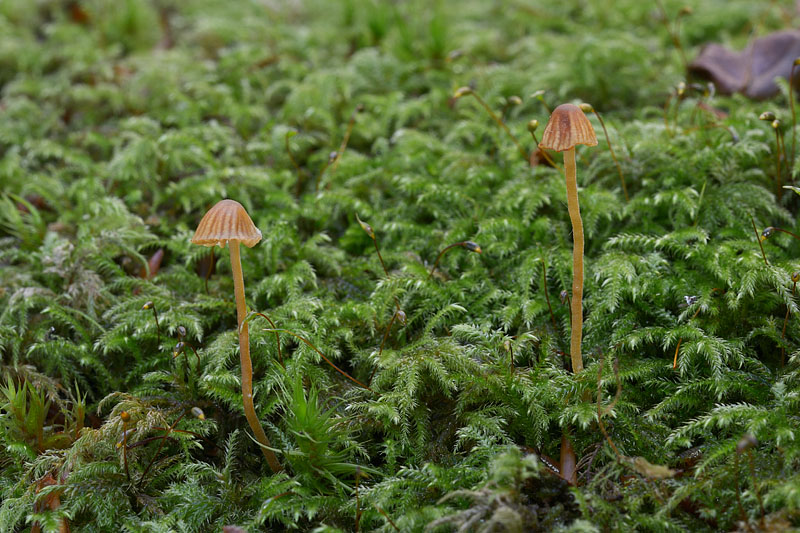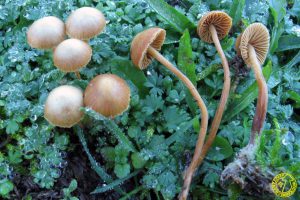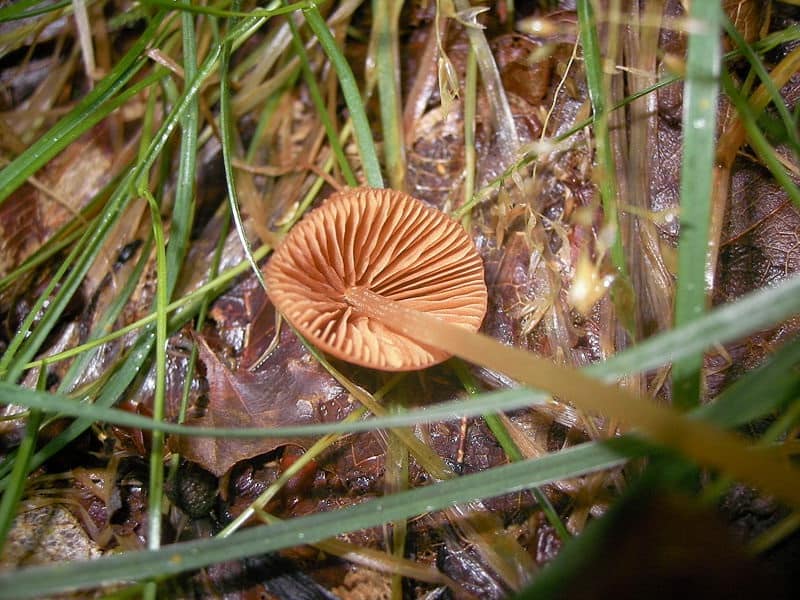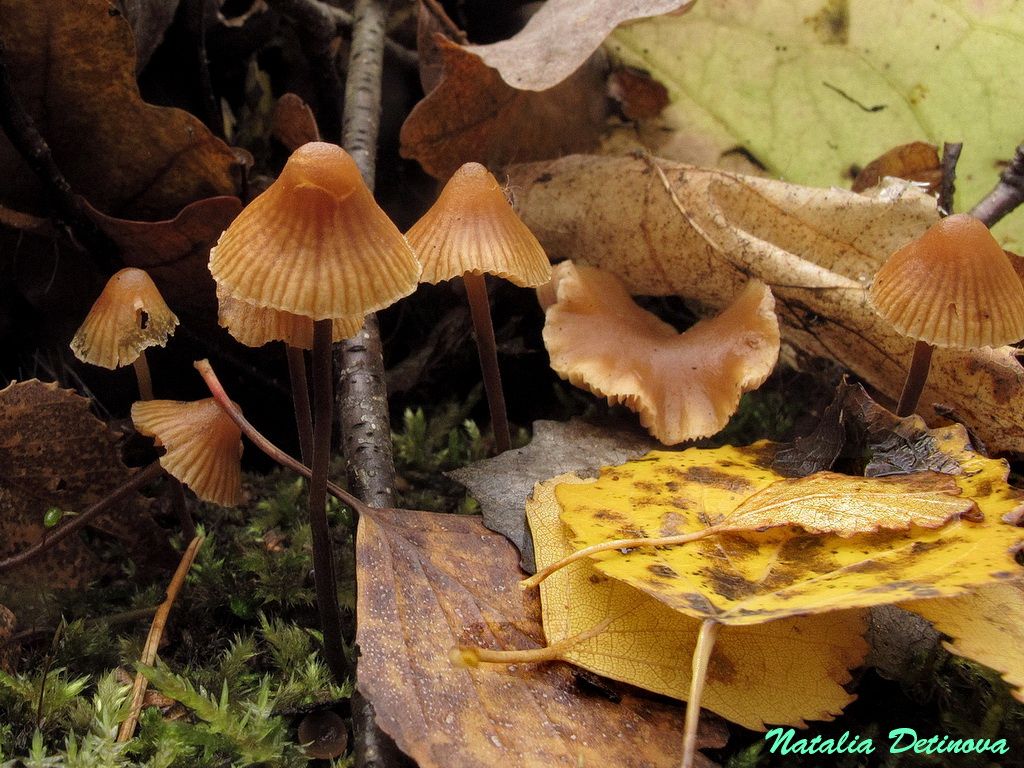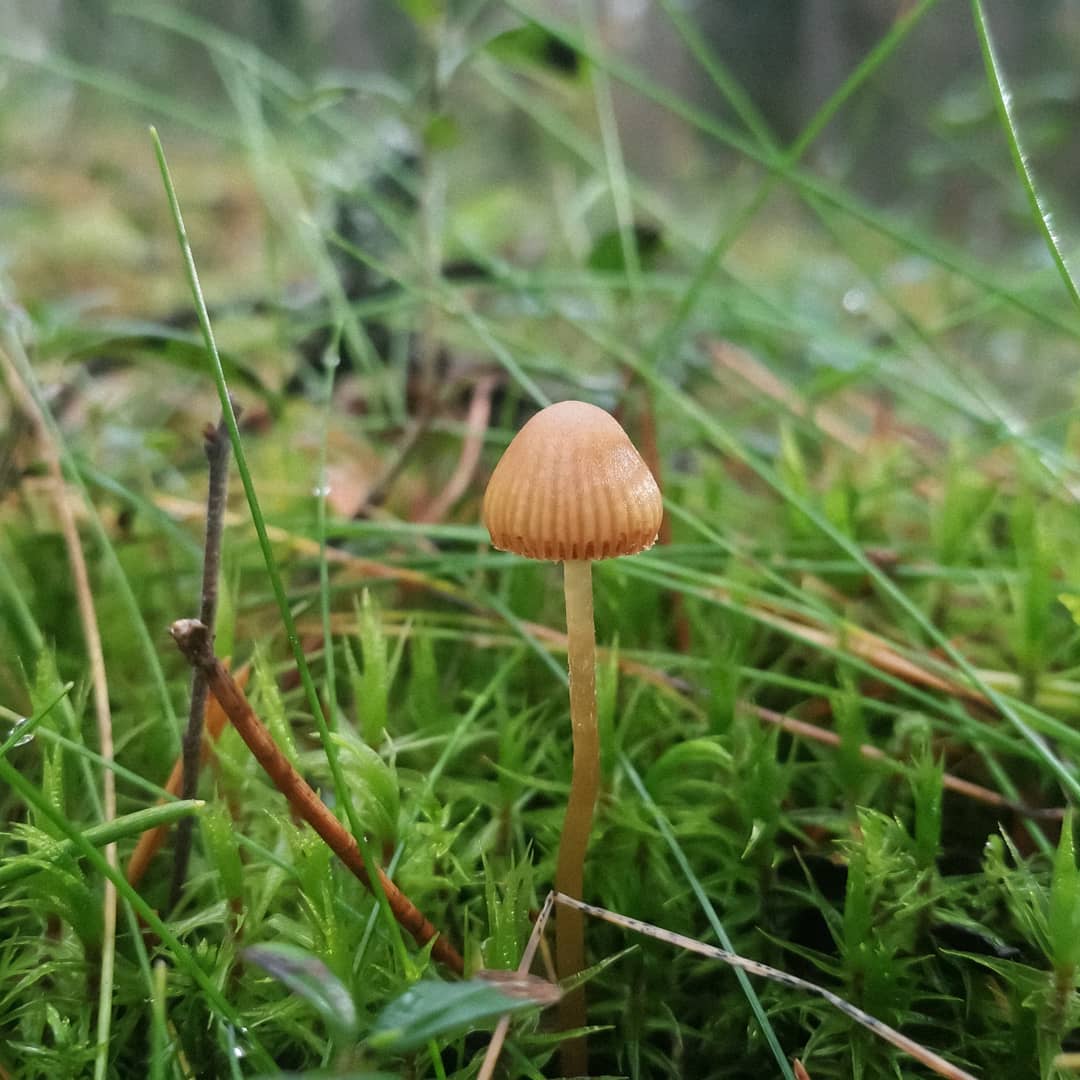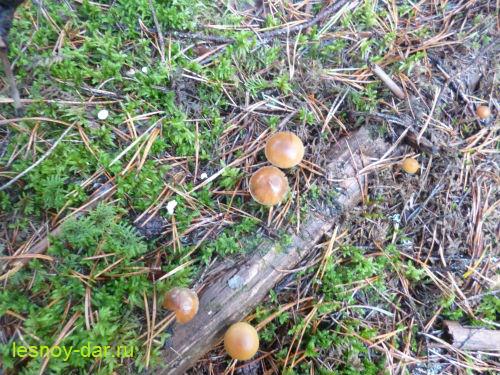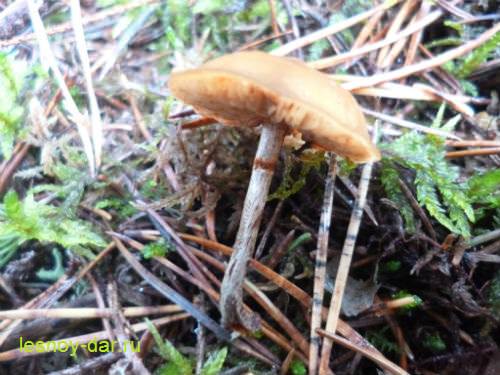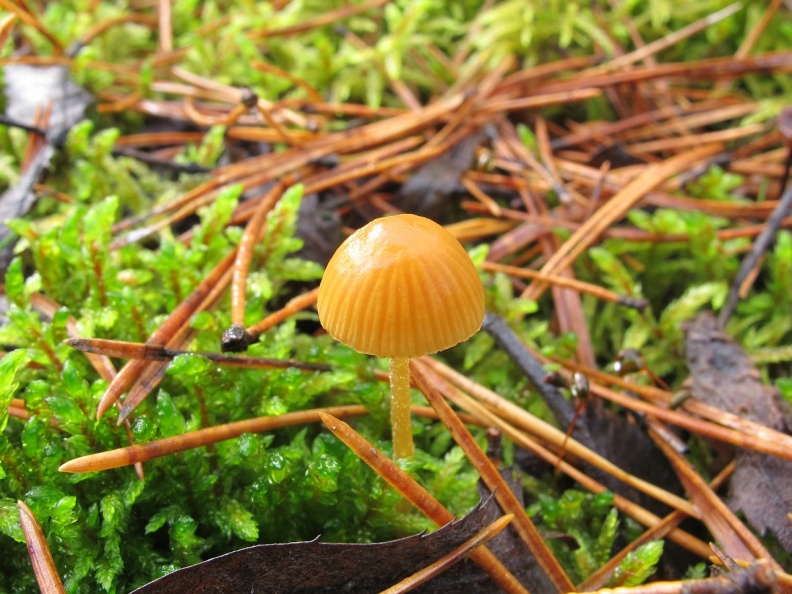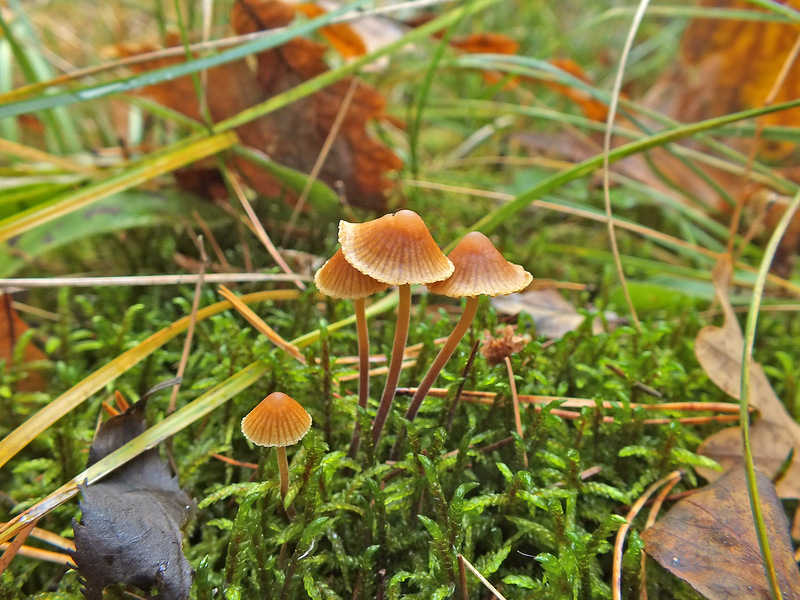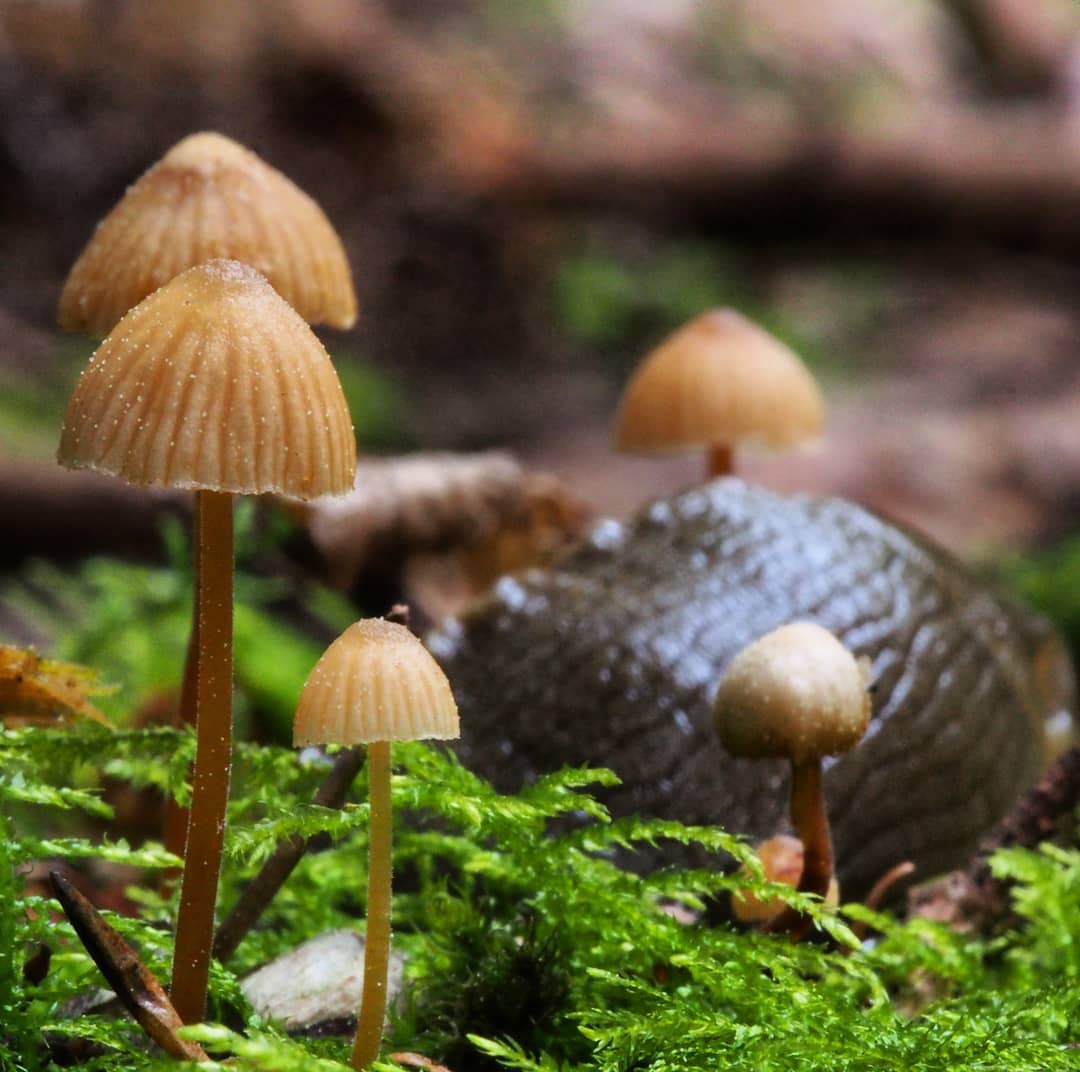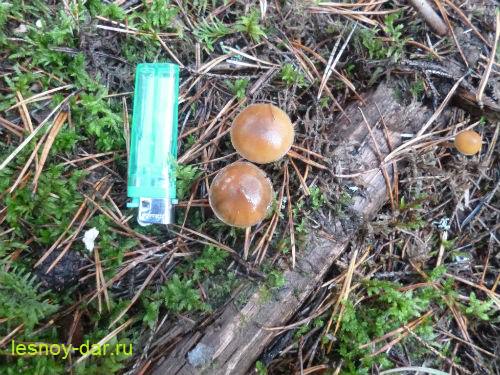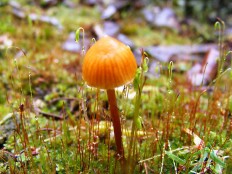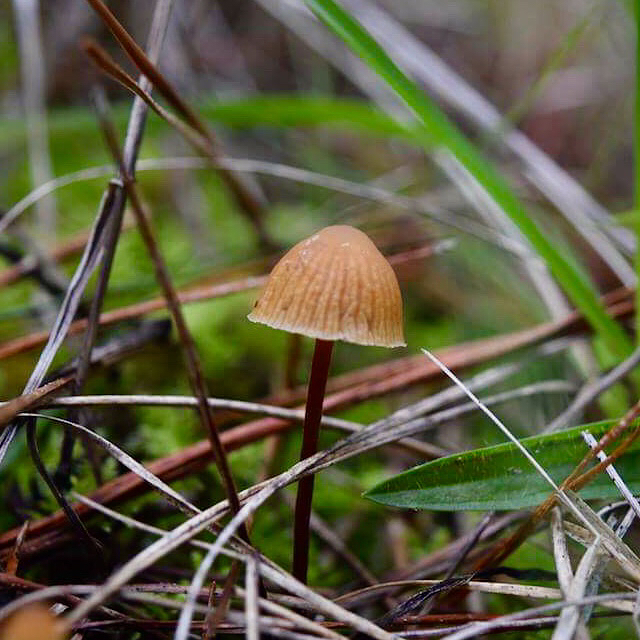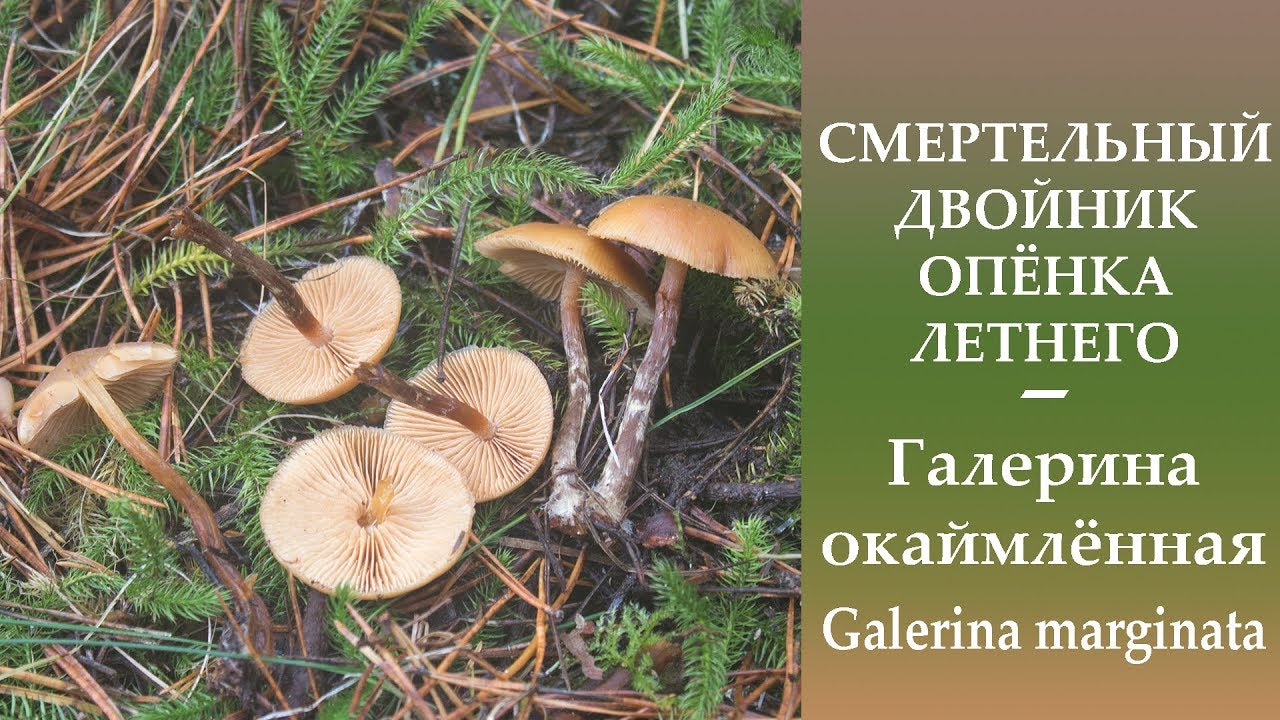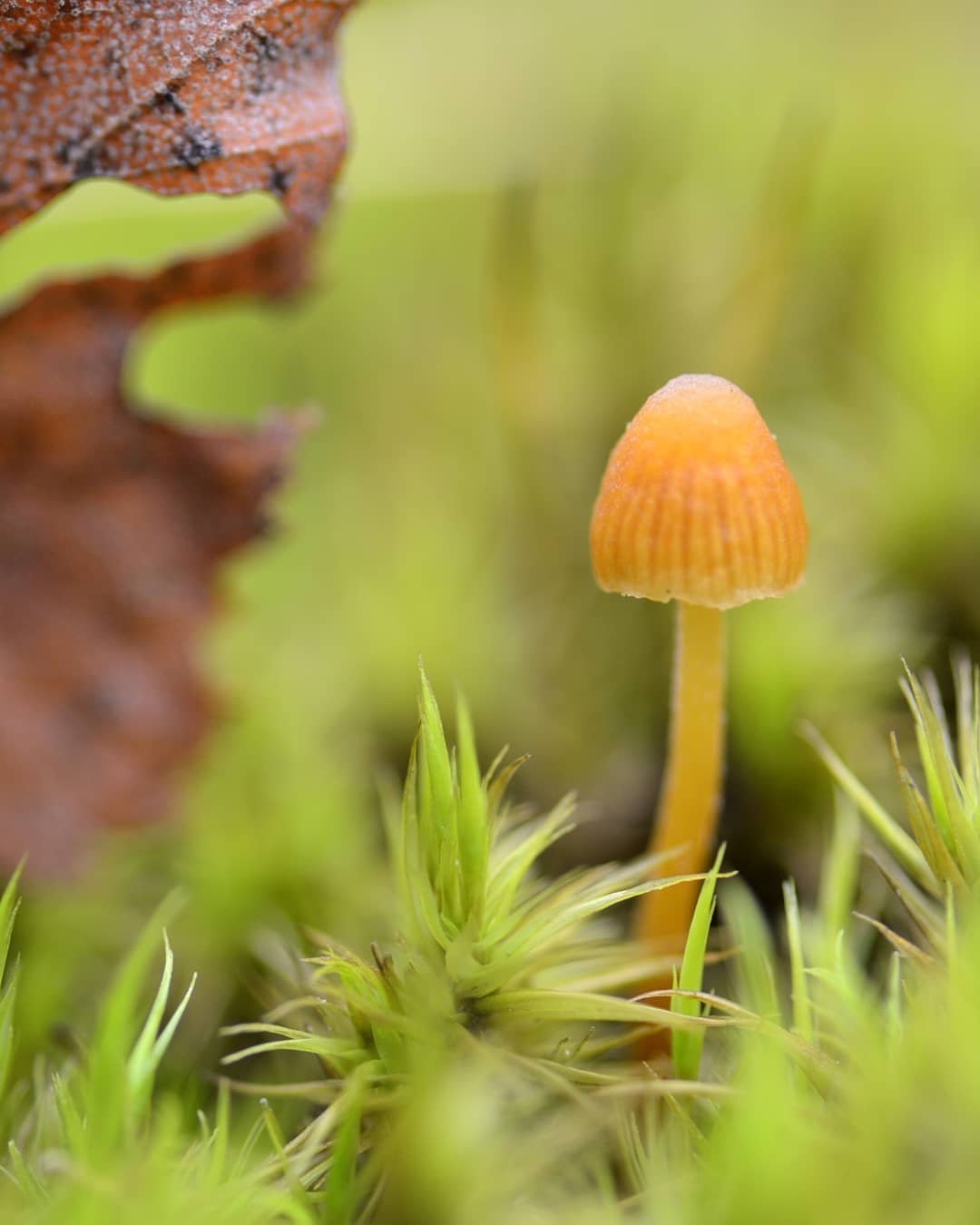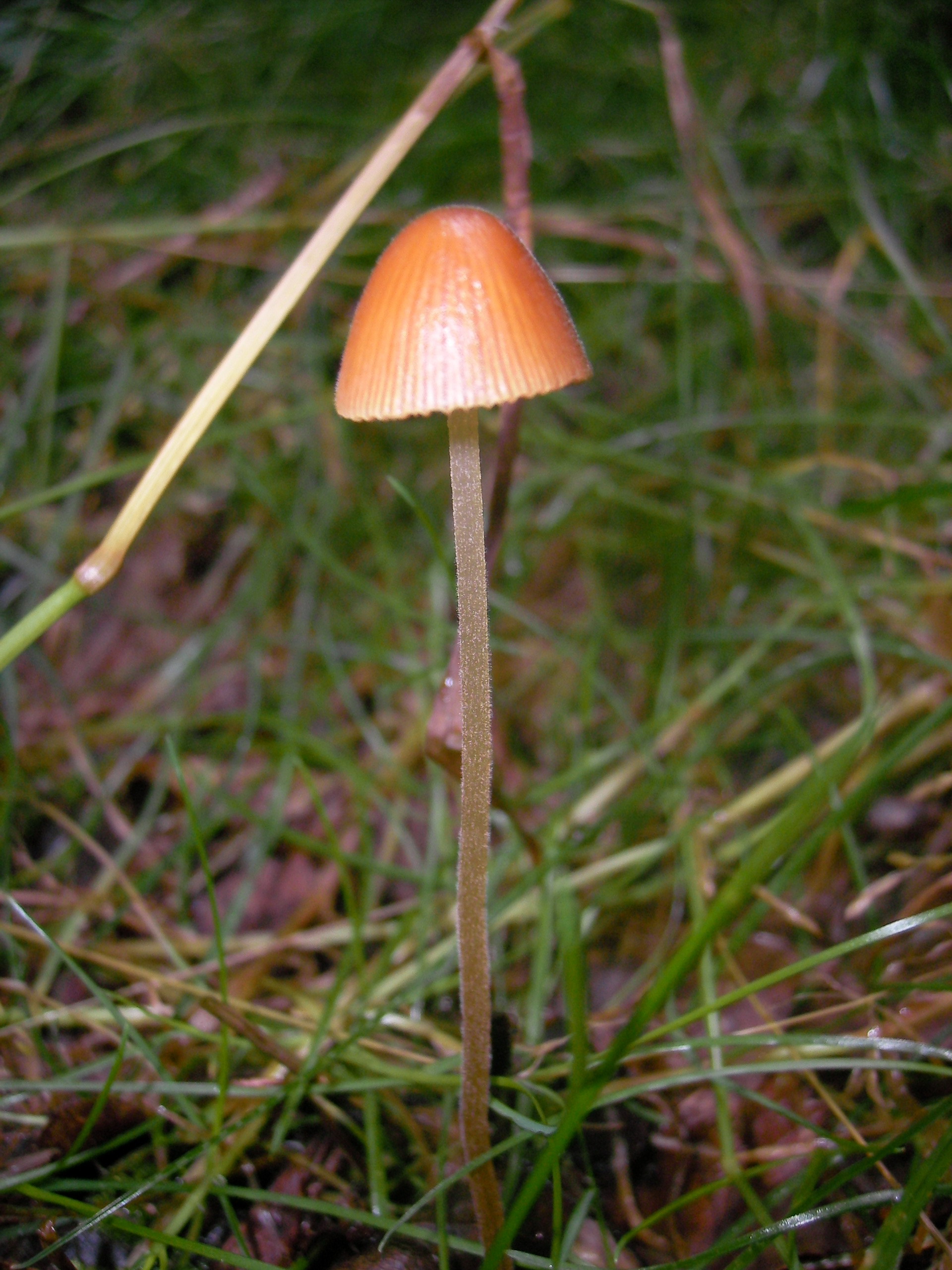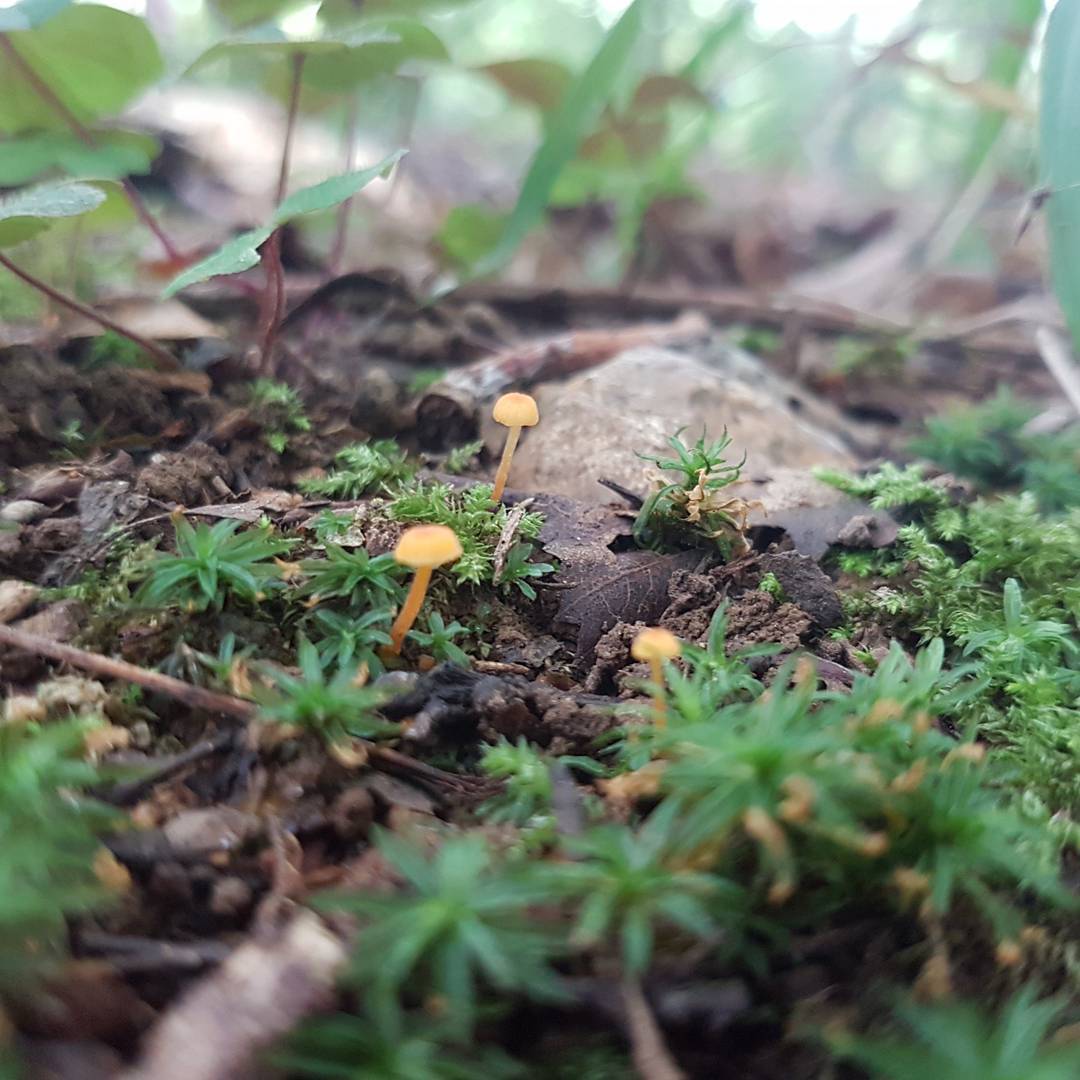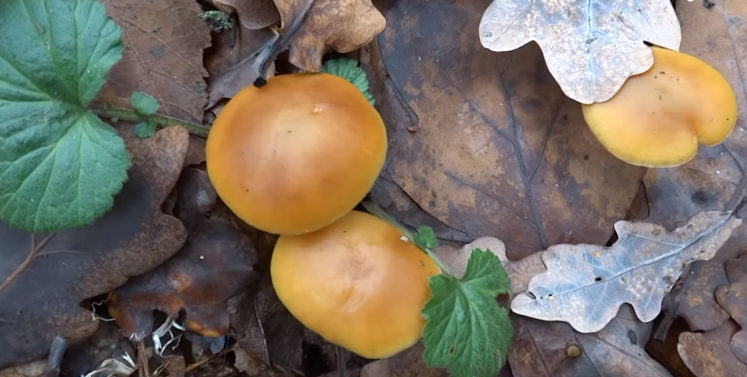How to distinguish Galerina marginata from honey agarics
The closest relative of the Summer mushroom is Woody, very similar to the gallery. The species is rare in forests. Therefore, only experienced mushroom pickers can afford to collect them in the forest.
Below is a photo that is worth paying attention to. Take a closer look: is there a difference between the views in the photo?
Difference with summer honey
Summer mushroom is similar to the gallery. To clearly show the difference between species, we offer a table for viewing.
Summer mushroom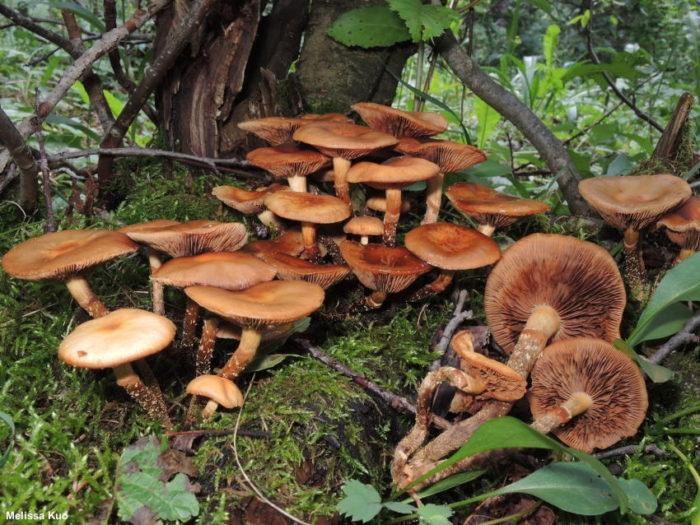 |
Galerina
|
|
| Fruiting | In groups, forming large aggregates. | Single fruiting bodies. Sometimes, 2-3 mushrooms grow together, no more. |
| Head diameter | Up to 6 cm. | 1.7-4 cm. |
| Lower part of the leg | Scaly. | Fibrous. |
| Taste and smell | Pleasant, fruity. | Mealy, mild. |
Differences between winter mushrooms
The main difference between gallerina and winter honey is the time of fruiting. It is rare that a poisonous mushroom grows in the forest until mid-November. Therefore, it is possible to collect winter mushrooms only after the onset of stable cold weather.
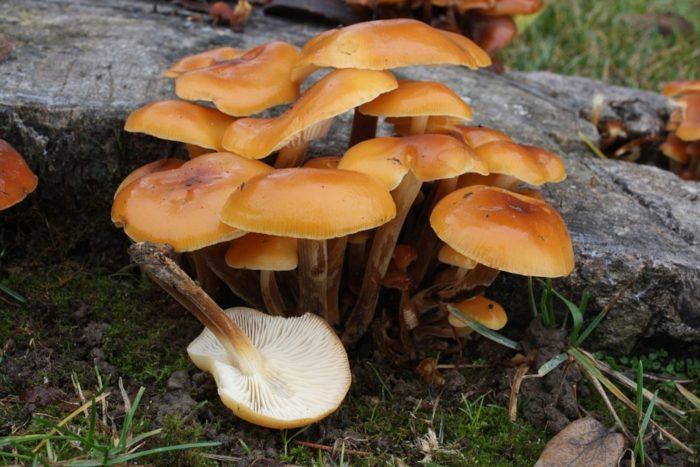 Winter honey mushroom
Winter honey mushroom
Recommendations that will help you not to confuse winter mushrooms with a gallery:
- cut fruit with legs. The caps of these mushrooms are similar, but the legs are different. Consider them: in honey agarics they are velvety, chocolate-colored, with a small fluff;
- winter mushrooms accumulate in piles, growing together;
- the gallerina's hat is dry and dull, in honey agarics it is wet, thickly covered with mucus;
- Galerina marginata has a ring on its leg (or its remnants, a dark belt).
Similarity with Autumn Openok
The only similarity between Autumn Openk and Galerina Bordered is the place of growth. Both species love to nest in wood. The mushroom looks more powerful, solid. Its leg is covered with flakes and scales, the flesh is thick. It grows in bunches.
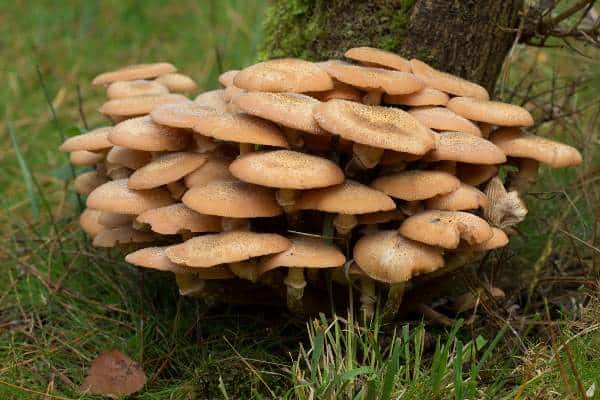 Autumn honey mushroom
Autumn honey mushroom
Galerina marginata
Synonyms:
Pholiota marginata
Photo by: Igor Lebedinsky
Galerina bordered (lat.Galerina marginata) is a species of poisonous mushrooms in the Strophariaceae family of the Agarikov order.
Bordered gallery hat:
The diameter is 1-4 cm, the shape is initially bell-shaped or convex, with age it opens to almost flat. The cap itself is hygrophilous, changes appearance depending on humidity; the dominant color is yellow-brown, ocher, in wet weather - with more or less pronounced concentric zones. The flesh is thin, yellow-brown, with a weak, indefinite (possibly mealy) odor.
Plates:
Medium frequency and width, adherent, yellowish at the beginning, ocher, then reddish-brown. In young mushrooms, they are closed with a dense and thick white ring.
Spore powder:
Rusty brown.
Gallerina leg bordered:
Length 2-5 cm, thickness 0.1-0.5 cm, slightly thickened below, hollow, with a whitish or yellowish ring. The top of the ring is covered with a mealy bloom, the bottom is darker, the color of the cap.
Spreading:
Bordered Galerina (Galerina marginata) grows from mid-June to October in forests of various types, preferring heavily decayed coniferous wood; often grows on a substrate immersed in the ground and therefore invisible. Fruiting in small groups.
Similar species:
Galerina bordered can be very unsuccessfully mistaken for a summer mushroom (Kuehneromyces mutabilis). In order to avoid fatal misunderstandings, it is strongly not recommended to collect summer mushrooms in coniferous forests (where they, as a rule, do not grow). It is difficult, if not impossible, to distinguish the bordered from many other members of the genus Galerina, but as a rule, it is not necessary for a non-specialist. Moreover, recent genetic studies seem to have abolished similar types of gallerina, such as Galerina unicolor: all of them, despite their own morphological characteristics, are genetically indistinguishable from the bordered gallerina.
Edible: The mushroom is extremely poisonous. Contains toxins similar to those of Amanita phalloides.
Video about the mushroom Galerina bordered:
Remarks There is a lot of confusion with this gallery. In Soviet popular publications you will not find a half-word about gallerina, despite its wide distribution in our country and presumably a dangerous similarity with summer forest (and the similarity at times is simply striking). According to some sources, Bordered Galerina is endlessly poisonous, others ignore her altogether, and in one translated book she was combined with summer honey without a shadow of embarrassment, called Galerina mutabilis and presented as a good edible mushroom. And these are stupid Western reference books, in which even the Valui are considered deadly poisonous! Is it possible to work in such conditions?
However, if we assume that the bordered gallery is really so poisonous, then the numerous poisonings by the “pale toadstool” become not so mysterious. Doctors who determine mushroom poisoning are deadly far from mycology. And they determine that death occurred as a result of poisoning with toxins of a certain group, which, as even a baby knows, are contained in a pale toadstool. And the fact that exactly the same poisons can be found in Galerina bordered, and in some representatives of the genus Lepiota, is unknown to medical science ...
Similar species
Similar varieties include wood mushroom, autumn and summer. There are some differences in which experienced mushroom pickers can avoid picking inedible mushrooms. With some species, they are well pronounced, but somewhere you can distinguish mushrooms by disputes, which relatively complicates the process of collecting mushrooms. It is difficult for experienced mushroom pickers to confuse gallerina with winter mushrooms, but beginners periodically confuse these mushrooms, this is due, as a rule, to the growth time and the moment that sometimes these mushrooms can grow on the same tree.
Galerina marsh
The diameter of the cap of this variety is 1-3 cm, but it can change with age. In shape, the young cap is a bit like a cone, while convex. With growing up, the shape is similar to a bell. Mature mushrooms have an almost flat cap shape, but a pointed tubercle of a convex shape protrudes in the center.
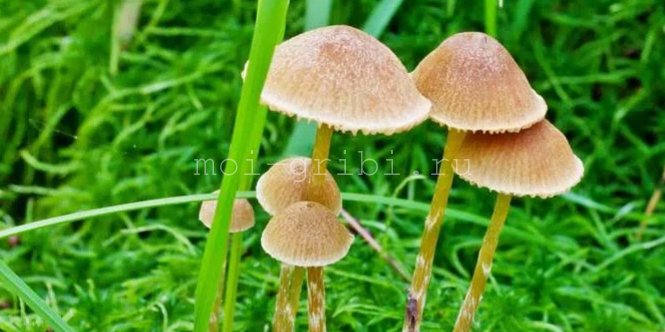
Under the influence of water, this part of the marsh gallery swells. The surface of the cap can be characterized by silkiness and smoothness. With the passage of time, the cap fading occurs. When the mushroom is young, the hat is under some kind of blanket or its remains of a whitish color.
If we compare the cap and the leg, which is hollow inside, then the leg is much larger in size, its length varies from 5 to 20 cm.The leg of a yellow-brown or green-yellow color can be characterized by its thinness and threadiness, the diameter does not exceed 0.4 cm.
You can see a white ring at the top of the leg. The leg is even in shape, sometimes it can bend. If you look closely at the leg itself, you can see the presence of a delicate flocculent plaque, below - a trace of the bedspread. The characteristics of the pulp are fragility and thinness, has no taste, the smell is weak, but pleasant. In color, the flesh and the cap are identical. There is either an accretion of light brown plates to the stem, or they fall. With age, the color of the plates darkens. The spores are broadly ovoid in shape.
The following areas can be distinguished where this fruit grows:
- North America;
- Europe.
Fibrous terrain, where there are a lot of mosses, is the habitat of such mushrooms, therefore this mushroom is called swamp gallerina. The plant bears fruit from June to September.
It is an inedible poisonous mushroom. If the mushroom picker does not know his features well, then you can expose your own life and your family to mortal danger, not excluding death. This mushroom contains bicyclic peptides that are slow to act. These are very poisonous substances.
Confused with summer honey
As for the classic summer honey fungus, it bears fruit in large aggregates.A gallerina has no more than two or three mushrooms, if it grows in a group. There is also a difference in size in these mushrooms: the honey agaric is larger than the fringed gallery. If you look closely at the mushroom leg, you can also find significant differences: it is scaly, but not fibrous. The pulp smells nice, you can even catch the fruity notes. The taste and smell of gallerina, in turn, is inexpressive, mealy.

The toxicity of the marsh gallerina
Marsh galley is an inedible and poisonous mushroom. Mushroom pickers should be well aware of the features of her appearance, otherwise they will put their lives in mortal danger.

Other mushrooms of this genus
Galerina ribbon-like has a cap diameter of 0.4 to 3 centimeters. Young mushrooms have conical caps, but later they open and become bell-shaped or almost flat, while a bulge is clearly visible in the central part. The hat is damp, it swells when exposed to moisture. Its color is honey-yellow with brown stripes. The length of the leg ranges from 3 to 12 centimeters, and the width does not exceed 0.1-0.2 centimeters. The leg is even, thin, inside it is hollow, brownish or light yellow in color, the lower part darkens over time to chestnut brown. Most often, the leg is without a ring. The pulp is thin, light yellow, fragile. There is practically no taste and smell in the pulp.
The ribbon-like gallerina is widespread most often in swampy areas, among sphagnum and moss. In Europe and the countries of America, these mushrooms are numerous. The toxicity of the ribbon-like gallerina has not been fully determined. Today it is not classified as an edible mushroom, and it is highly undesirable to use it for food.
Galerina sphagnum has a tiny hat - from 0.6 to 3.5 centimeters. In young mushrooms, the shape of the cap is conical; over time, it opens to hemispherical and convex. The surface can be fibrous or smooth. The fungus has the ability to absorb moisture. The cap is ocher or brown; it becomes lighter as it dries.

The tubercle on the cap is more saturated. At a young age, the edges of the cap are fibrous. The leg is thin and long - from 3 to 12 centimeters. The stem is hollow in structure, and its surface is longitudinally fibrous. The color of the leg is usually the same as the hat. The ring from the leg quickly disappears, but the remains of the bedspread remain visible. The pulp is brittle and thin.
Sphagnum gallery grows from June to September. They grow in Europe, South America, North America and Asia. In general, these mushrooms grow everywhere, with the exception of Antarctica. They prefer swampy areas and damp places. They grow in whole families or singly. The toxic properties of sphagnum gallerina have not been studied, therefore these mushrooms are not classified as poisonous, but they are not considered edible either. They are not used for food, since many species of this genus cause severe poisoning, then it is not recommended to collect sphagnum gallerina.
The bordered gallerina, like the rest of the gallerina, has a small hat with a diameter of 1-4 centimeters. Its shape is bell-shaped at first, but over time it straightens out. The color of the cap is ocher or yellow-brown. The length of the leg is 2-5 centimeters, and the width does not exceed 0.1-0.5 centimeters. The leg is thickened in the lower part. There is a whitish or yellowish ring on the stem. The upper part of the ring is covered with a mealy bloom, and the lower part is darker.
Bordered gallery grows from June to October. These mushrooms are found in forests of various types, giving preference to strongly rotted coniferous wood. Often these mushrooms are completely immersed in the substrate, so they remain invisible. They bear fruit in small groups. This mushroom is extremely poisonous, it contains toxins characteristic of the pale toadstool.

The most famous types of gallerins
Galerina ribbon-like is found in wetlands. These mushrooms grow on mosses
How poisonous the ribbon-like gallerinas are is not fully understood, but mushroom pickers do not pay attention to them anyway, because they are very small
The hat is small, convex.The color of the cap, like the rest of the species, is yellowish or brown with dark radial stripes. The plates are cream or light brown in color. The pulp is thin and fragile, it has absolutely no smell.
The bordered gallerina contains the same poison as the pale toadstool. Symptoms of poisoning appear after a day, diarrhea, vomiting, frequent urination, thirst and convulsions occur. After 3 days, an imaginary improvement may occur, but after that jaundice develops, and the person dies due to liver problems.
In our forests, the fringed galley appears in August and bears fruit throughout September. These mushrooms grow only in conifers, mainly on old wood.

The hat is small - no more than 3 centimeters in diameter. The surface of the cap is sticky. At a young age, the cap is convex, and then becomes almost flat. Her color is dirty yellow. The plates are frequent and narrow, of the same color as the cap. The pulp is watery, yellow in color, practically odorless. The stem is long, fibrous, hollow inside. The color of the leg is the same as that of the cap, but slightly darker at the bottom.
Poisonousness of gallerina moss
These mushrooms belong to the poisonous group. Galerina moss is not easy not edible, but it also carries a great fall for health and even human life. The peak fruiting of gallerina moss coincides with summer and winter mushrooms
Therefore, it is extremely important for mushroom pickers not to confuse these mushrooms. Outwardly, mushrooms and gallery owners are similar, they can be confused even by professionals, and even more so by amateurs
Other mushrooms of this genus
The bordered gallerina has a slightly larger hat - its diameter is 1-4 centimeters. At first, the shape of the cap is bell-shaped, but as it grows up, it becomes almost flat. The color of the cap changes depending on humidity, the most common is yellow-brown color, and in wet weather concentric zones appear. The flesh is thin and pliable, ranging in color from pale brown to almost white. The leg length is 2-5 centimeters, and the width does not exceed 0.5 centimeters. The leg is hollow, somewhat thickened in the lower part, with a yellowish or whitish ring. The part of the leg above the ring is covered with a mealy bloom.

This is a very poisonous mushroom with a flour smell. They contain the same toxins found in pale toadstools. The fringed gallery grows from June to October. These mushrooms settle in different types of forests, preferring decayed coniferous wood. They bear fruit in small groups.
Galerina ribbon-like has a hat with a diameter of no more than 0.4-3 centimeters. At first, its shape is convex, over time it becomes almost flat with a wide tubercle in the central part. The hat is capable of swelling under the influence of moisture. The color of the cap is honey-yellow with brown stripes. The length of the leg ranges from 3 to 12 centimeters, and the width does not exceed 0.2 centimeters. The leg is even, thin, hollow inside, brownish or light chestnut in color. Stem rings are usually not available.
Galerina ribbon-like grows in swampy areas, meeting among sphagnum and moss. These mushrooms are plentiful in Europe and America. Their toxicity is not fully understood, which is why it is highly undesirable to eat them.
Galerina marsh has a bell-shaped cap, which becomes prostrate as it grows, while a clearly visible sharp tubercle remains in the center. The diameter of the cap is 2-3 centimeters. The cap is watery, smooth, at a young age covered with the remains of a whitish blanket. The color of the cap is yellow-brown or whitish-yellow, but in old mushrooms the caps fade and become dark yellow. The leg is long, filiform, 8-13 centimeters high. The leg is extremely thin, light yellow in color, mealy. There is a white ring at the top of the leg.

Galerina marsh is widespread in forests of various types, most often it is found among sphagnums and in wetlands. These mushrooms are widespread in Europe and North America.They grow in small groups, and most often singly. Galerina marsh is not used in cooking, as it refers to poisonous mushrooms.
Galerina sphagnum has a hat with a diameter of 0.6-3.5 centimeters. Young mushrooms have a cone-shaped cap, but over time it becomes hemispherical. The surface of the cap is smooth, but sometimes fibrous. The hat is capable of absorbing moisture from the environment. The color of the cap is brown or ocher, as it fades, it becomes yellowish. The tubercle on the cap has a more intense color. The leg is thin, even, 3-12 centimeters long and 0.1-0.3 centimeters wide.
Sphagnum galleys grow from June to September. Their habitat is quite wide: South and North America, Europe and Asia. These mushrooms can be found almost everywhere on the planet, with the exception of the ice of Antarctica. They prefer damp places and swamps. These mushrooms can grow individually or in families.

Galerina is poisonous, be careful!
The danger of all varieties of the gallerin mushroom is that information about this type is absolutely not widespread. In our country, in most sources by biologists, gallerina is classified as a species of summer mushroom. This is fundamentally wrong.
The symptoms of poisoning are similar in their signs and consequences to the pale toadstool. The fact is that the gallery contains the same set of poisons and toxins as this deadly mushroom. Therefore, often when a patient is admitted, poisoning with a mushroom toadstool is diagnosed.
At the same time, the degree of distribution of gallerina in Russia is several dozen times higher than the frequency of occurrence of pale toadstool. Be careful and carefully collect mushrooms, especially those that have counterparts in the poisonous mushroom kingdom.
Where does the bordered gallery grow?
Galerina bordered grows in coniferous and mixed forests with a predominance of conifers. Loves warmth and moisture. Dense or small clumps of fungus can be found in moss, decaying wood (coniferous), and predominantly coniferous tree stumps. Sometimes it "descends" to the ground if rotting wood of a coniferous plant lies close to the surface.
M. Vishnevsky writes:
However, summer mushrooms may not grow in a bunch.
Until recently, this poisonous mushroom was found mainly in forested mountainous terrain, now it began to actively populate our lowland forests, adapting to the climate of central Russia.
Galerina bordered grows in summer (from mid-June) and autumn (to October). In August and September, the likelihood of stumbling upon this poisonous mushroom increases.
General description and photo of Galerina bordered
Galerina edged is a woody fungus. Has similar features with mushrooms. It is quite difficult to distinguish it from summer woody and winter honey agaric, and it is also very difficult to find the distinctive features of Galerina marginata (from Latin) in comparison with autumn honey agaric. In terms of fruiting period, this mushroom varies from July to October, sometimes bears fruit until the middle of the last autumn month.
Hat
The diameter of the cap ranges from 0.5 -3 cm. It is defined as bell-shaped or convex, the edge is wrapped inward, this design is at the beginning. Further, the cap becomes convex or almost flat, you can see a small tubercle, the edges are weakly translucent. The cap of such a mushroom is moist and characterized by light stickiness, yellow-brown shades or reddish-brown can be distinguished in color, it can also be dry and shiny, here the colors vary from yellow to yellow-ocher-brown.
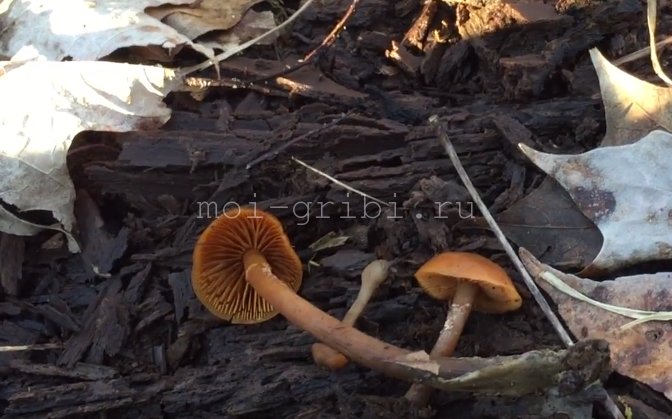
The color of the plates also varies from yellow-ocher to yellowish-brown, there is also a part where a reddish-brown color is present. The plates themselves grow widely, there is a tooth that slightly covers the leg, they are located quite often, and are narrow in width. The color of the pulp is yellow-brown, the taste and smell are of flour.
Leg
It is characterized by a length of up to 8 centimeters, a diameter of 0.1-0.5 cm, a slight thickening at the bottom, hollow.Upon closer examination, you can see a ring with a powdery bloom, above it is a white, yellowish or brown ring, a fibrous, whitish coating may also be present below, a one-color white cap.

Edibility
Galerina bordered is classified as a deadly mushroom, contains -, - and -amanitins. There is a certain amount of consumption of this mushroom, which can be classified as dangerous. The liver is damaged, and vomiting, diarrhea, and chills begin. If timely medical care is not provided, then such food can be fatal.
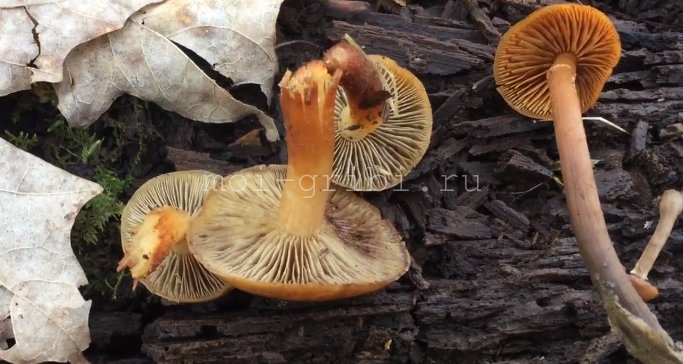
Toxicity
Studies were carried out by European and American scientists, where it was revealed that phallotoxins are present in mushrooms, but with the latest research this substance was not detected. Fresh mushroom amatoxins can range from 78 to 270 mcg / g, more poisonous than pale toadstool. The lethal dose of amatoxin is 0.1 mg / kg of human weight. Based on this calculation, then, after eating 10 small mushrooms, death can occur for a child weighing 20 kg. For more than 100 years, mankind has known about the toxicity of this fungus. Fatal poisoning from this fungus occurred in 1912 in the United States.
Description, taste and smell of the deadly mushroom
Galerina marginata is a tree fungus. Belongs to the family of stropharia, the class of agaricomycetes. Secrets a poison similar in composition to the Pale Toadstool. Some mushroom pickers claim that gallerina can smell like a radish. The taste is insipid, not pronounced.
Hat
The diameter of the cap is from 0.5 to 3 cm. At first it is convex (or bell-shaped), with a curled edge. Then convex (or flat), with a small tubercle and faintly translucent edges. Absorbs water. Therefore, when wet, yellow centric circles appear on the mushroom. Spore powder is rusty.
Hymenophore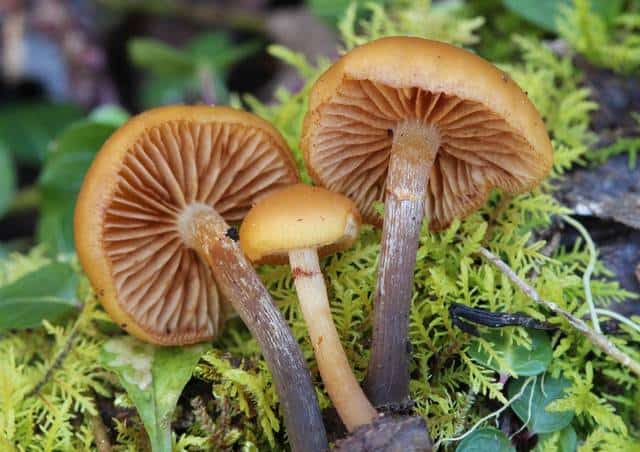
The plates under the cap grow with teeth, fall down on the leg. Frequent, narrow. In the process of growth, they change their color: from yellow-buffy to reddish-brown. In young mushrooms, the hymenophore is covered with a dense, dense veil.
Pulp
The pulp is loose, yellow-brown (dirty) color. It breaks easily. If you smell it, you can smell the flour.
Leg
Quite characteristic, somewhat thickened downwards, empty. It grows up to 8 cm in height, usually lower (2-5 cm). Thin, thickness from 0.1 to 0.5 cm. In color, similar to the cap. Covered with a mealy bloom, which is simply erased in contact with fingers.
Habitat
The edged galley mushroom is widespread almost everywhere, most often found in Europe, the Caucasus and Central Asia, in North America, in Russia and even in Australia.
It lives mainly in swampy and forest areas. It grows, as a rule, on decayed coniferous or deciduous wood, near trunks, on stumps, and occasionally also occurs on moss-covered soil.
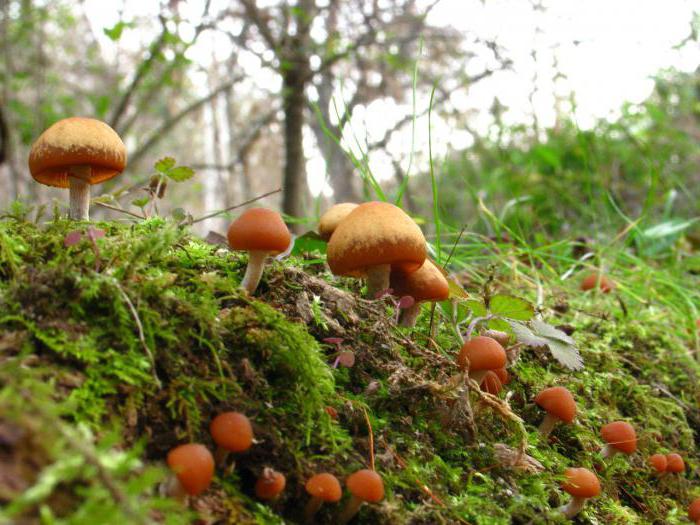
Usually a galley bordered already appears in June, but the mass release of these mushrooms occurs from August to October, and with a long warm autumn, you can find them in November. Most often they grow singly. Fruiting usually occurs in September and lasts until November.
Taxonomy
Singer and Smith distinguish several varieties and forms of this species:
- Galerina vittiformis var. vittiformis f. tetraspora with four-spore basidia and a darker coloration of the lower part of the stem.
- Galerina vittiformis var. albescens f. tetraspora with quadruple basidia and uniformly colored stem.
- Galerina vittiformis var. pachyspora with a blanket present in young fungi, double-pore basidia, and spores 11–12 × 7.5–8.2 µm.
- Galerina vittiformis var. vittiformis f. vittiformis with two-spore basidia, narrower spores, and an unevenly colored stalk.
- Galerina vittiformis var. albescens f. bispora with queen-sized basidia and evenly colored stem.
- Galerina vittiformis var. subannulata with one-, two- or three-spore basidia and a well-visible ring.
Time and place of fruiting
It settles in coniferous forests, pine forests, swampy areas.Loves warmth and high humidity. Basically, it multiplies on wood, hemp, roots, tree trunks. Rarely - in woody rotting soil, mosses. The fruiting period begins in early July and ends in October. If the autumn is warm, mushrooms can be found in mid-November.
Recently, it is often found on the territory of Russia. Especially in the European part. Grows in the Crimea, the Caucasus, the Urals, Southern Siberia, the Far East. Previously, it could not be found in Moscow and the regions. But due to the changing weather conditions, Galerina marginata appeared in the metropolitan forests. August rains are getting less and less, summer is dry. The soil dries out and is not sufficiently saturated with moisture. Toxins accumulate more strongly in mushrooms, since there is not enough moisture to neutralize the poison. The variety is widely distributed in the Leningrad region.
Poisoning symptoms and first aid
You can feel poisoning with this fungus in a day, it does not appear immediately. The first symptoms include:
- vomit;
- diarrhea;
- increased urination;
- chills.
3 days pass, the symptoms disappear. It feels like an improvement is taking place. signs of jaundice are noticeable, liver functions are impaired, and the person dies as a result.
For children, mushroom poisoning is more difficult, up to irreversible processes. Here it is necessary to understand the seriousness of the situation. Not only the liver suffers, but also the nervous system. With the growth of poisoning, there is a strong thirst and convulsions.
If a person touches a dangerous mushroom, you must thoroughly wash your hands and treat them with an antiseptic immediately. The spores of the fungus are very difficult to destroy; they can enter the body not only with food, but also through the hands.
There was a statement that in case of poisoning it is necessary to consume alcohol, and it will help remove the poison from the body, but it is incorrect. It is necessary at the first symptoms of poisoning to immediately call an ambulance. If you do not provide it, then intoxication will increase.
First you need to take 1 tablet of activated carbon per 10 kg of weight. You also need to drink warm water with salt in a ratio of 1 teaspoon per glass. Drinking a mild light pink solution of potassium permanganate also helps. Induce vomiting and drink plenty of water. Provision of rest and bed rest is mandatory, and arms and legs will need to be provided with warm heating pads.
general description
Galerinae are small-sized soil and woody saprophytes of the Cortinariaceae family. The main features are yellowish-brown caps with adherent plates and brown spore powder. Determination of species affiliation is sometimes difficult, since these signs are not so obvious. In total, there are up to several hundred types of gallerines. In different sources, these data differ, so it is difficult to talk about the exact amount. Significant adjustments have been made as a result of the current genetic research of fungi belonging to this genus. Among them, a bordered gallery is considered extremely poisonous, a photo of which and a description are presented in this article.

